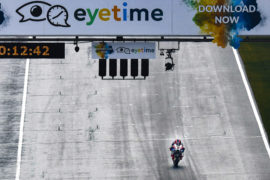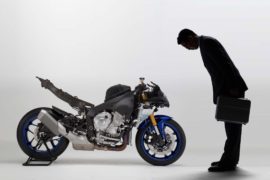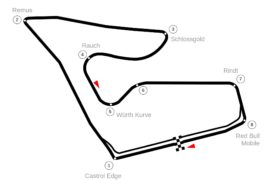Well, we knew the weather was going to be a factor at the Sachsenring, and we weren’t disappointed. (Or perhaps we were, depending on your point of view.)
The MotoGP riders started off on a bone dry track in the morning, spent an extended 55 minutes on slick tires, then suffered through a couple of full on rain showers in the afternoon. They had time on a dry track, and time on a wet track, and time on a track with a dry line forming.
It was the perfect preparation for what promises to be a weekend of mixed weather. The chances of making it all the way to the race on Sunday without another wet session are very small. But they are also not zero.
Riding in both weather conditions gave the riders a chance to assess the grip of the new surface. The response was overwhelmingly positive. Aleix Espargaro summed up the general impressions, and entirely in character, he also summed it up with the most enthusiasm.
“It’s unbelievable,” the Aprilia rider said. “They did a super job, a fantastic job. The tarmac has zero bumps, nowhere. The grip is super high. Actually, I think we finished five seconds from the dry times, which is very very very fast. So, German style, they did a great job!”
The grip was generally judged to be good in the dry, but absolutely phenomenal in the wet. “Honestly, in the wet you can’t believe it,” Cal Crutchlow told us.
“I left the pit lane. I was late because we were messing around in the garage. Marc had done three laps. I saw the blue flags, sit up and I looked down and Marc’s got his elbow on the floor! When I see someone’s got their elbow on the floor it means you’ve got to push.”
More Grip = More Speed = More Crashes
The grip in the dry ended up catching a few people out. For most of the FP1 session, the new asphalt and newly reprofiled Turn 11 did not claim any victims. Until the last ten minutes or so, when Alvaro Bautista, Scott Redding, and Andrea Iannone.
“We’ve seen many crashes like this in the past, like mine this morning,” Bautista said. “Just with the new asphalt I felt the grip was better than other years so I tried a bit more, a bit more, a bit more and then I crashed. So maybe I had a lot of confidence in that corner. Maybe you have to leave a bit more of margin for the race in that corner.”
The crashes had all come at the end of the session, when riders started chasing a quick time. “This morning, everybody went with the soft front, which was not so bad,” Marc Márquez said.
“The crashes arrived when the people put the new soft rear and medium front. Because then, the new rear with good grip is pushing the front, and then it’s so easy to lose it.”
Turn 11 remains a terrifying place. “It’s true that it’s a very fast corner, and honestly this morning, I was losing one tenth there, because in FP1 you always try to take care, you don’t want to take a risk because you are around 220 km/h there and a crash is always hard,” Marc Márquez admitted.
Asked if he enjoyed the challenge of such a fast and difficult corner, Márquez deflected handily. “When it’s sunshine, yes. When it’s cold, not a lot!” he joked. “I mean, I prefer left corners, there’s only three right corners, but I prefer the left ones.”
No Easy Fixes
The reprofiling had made very little difference to the corner. “For me no difference,” Aleix Espargaro said. “I believe them, because they’re German, if they say they changed 1.2°, I believe them.” Cal Crutchlow pointed out the problem with such a change.
“The thing is, if you give us two percent more camber it means we’re going to open the throttle 0.2% more.”
The added grip hadn’t helped either, for much the same reason, according to the LCR Honda rider. “The problem is you’re going to keep going as fast as you can until you crash. It’s as simple as that. I know that’s the point of racing. You have to find the limit,” he explained.
But Scott Redding’s crash was an example of how treacherous the corner still is. “Honestly, I have to say Scott Redding did nothing wrong. I have no idea why he crashed. He heated the tire, did three or laps before. There it’s so tricky.”
“The worst thing was I came in after the first run and said, ‘There must be more grip at turn eleven because no one is crashing.’ The next time I went out they were crashing everywhere. You see Hector Barbera in the rain, he gained his whole lap time there because he took a risk.”
Crutchlow believes it is time to find a fix for Turn 11, a way to slow the riders down there, before someone is seriously hurt.
“At the end of the day, you have to look at how many crashes there are over a year. Then you have to look at today. Bikes flying through the air and marshals not even hearing them. They’re not even looking at them, the bike’s coming, and they probably can’t hear it to be fair. Another rider could be laying in the gravel, a bike could fly in.”
Fixing Turn 11 is a recurring complaint, but it remains very difficult. If the track adds more camber, more banking to support the riders through the corner, they will simply take it at a higher speed, Marc Márquez pointed out.
“To slow down, you need to change all the layout,” he said. And given the limited space there, there are not a lot of options. Attempts at making the corner tighter had not met with any success. And so the issue will linger, until someone finds a creative solution to what remains one of the most glorious corners on the calendar.
Tire Testing Too
The rain in FP2 did throw a spanner in the works of tire testing. Michelin had told the riders that they all had to do at least five laps on the hard rear with the stiffer construction, a tire based on the one used in Argentina.
The majority had managed it in the morning – and many had really liked the tire, regarding it as a genuine option for the race – but ten riders had saved the tire for the afternoon, then lost the opportunity to try it when the rain had come.
That forced Dorna to extend FP3 as well, to ensure that the remaining riders also put in the laps. If it rains in the morning, then they will have to use the tire in FP4. If it rains in FP4? Well, they’ll be on their own.
Friday at the Sachsenring did highlight the downside to being a spec tire supplier. At Barcelona, there was much complaining about tire degradation, and the media was full of complaints that Michelin were not up to the job.
At the Sachsenring, everyone was happy with the tires, and so Michelin were entirely ignored. Being a spec tire supplier means the riders only talk about your tires when things are going badly.
When things go well, the riders remain silent. The only time the riders heap praise on a spec tire supplier is after they announce they will be leaving, as happened to Bridgestone. But that is not a trick you can pull off very often.
Why do they do it? Because motorcycle shops and tire fitting places around the world will have giant posters adorning their walls with pictures of Valentino Rossi, Marc Márquez, Maverick Viñales wearing Michelin caps on the podium.
That silent branding is evidently more valuable than the noisy complaints that arise from time to time.
But the tires will be a factor at the Sachsenring. Even before it was resurfaced, the fact that the bikes spend such a long time on the left-hand side of the tire causes an inordinate amount of wear on that side. By the end of 30 laps, that will have come into play. Conserving your tires will be crucial in Germany.
Honda vs. Yamaha vs. Ducati vs. Aprilia?
In previous years, the Sachsenring has been something of a Honda track, Hondas having won here for the past seven years straight.
Yet it was two Ducatis who were quickest on Friday, Andrea Dovizioso topping the timesheets in the morning, while Hector Barbera put in a remarkable time in FP2 to go fastest in the afternoon. Their fates had been reversed in the changing conditions, Dovizioso struggling in the wet, Barbera positively invisible in the dry.
The field changed behind them as well. Maverick Viñales was fast in the dry, but struggled badly in the wet. Marc Márquez was sixth fastest in the dry, but second fastest in the wet, just ahead of Repsol Honda teammate Dani Pedrosa.
Dovizioso was mystified by the problems in the wet. At Assen, they had fought with finding rear grip, whereas at the Sachsenring, it was the front end of the bike they were having problems.
Viñales was similarly struggling in the wet, a lack of feeling from the front hampering him. The bike was still strong on braking in the wet, but once he released the brakes, the problems appeared, Viñales said.
For teammate Valentino Rossi, he had been hampered by a technical problem in the morning. His number 1 bike packed up, and the Italian was forced to abandon it at an unfortunate point on the circuit.
That bike had his preferred chassis in, and he was unable to get the same feeling from his second bike with the standard 2017 frame, which has caused him problems all year.
It was acceptable in terms of race pace, but once he stuck a new tire in to chase a spot in Q2, Rossi simply couldn’t get the feeling with the front tire.
Field Wide Open
The fact that there were Ducatis, Hondas, Yamahas, even Aprilias – Aleix Espargaro was fourth in the morning, and fifth in the afternoon – all at the top of the timesheets laid to rest the myth that there were Honda tracks and there were Yamaha tracks, Jorge Lorenzo said.
“I think that there is not, apart from Jerez for example… if you feel good with any of the top four bikes you can have options to win,” Lorenzo said.
“It is not a Honda or Yamaha track like 5-7-10 years ago, especially in the 800 era when there was clearly some [advantage] for Honda. If you didn’t have a Honda it was very difficult to win. Now if you feel good with the bike… maybe only Aprilia and KTM are one step behind.”
The biggest change had been to the technical rulebook, Lorenzo explained, but also the requirement that factories supply more teams with good bikes had been a help.
“New electronic, the rules, Michelin tires, more guys on the limit, more competitive bikes… All these things, but especially electronics and tires,” the Spaniard said.
Can Marc Márquez make it eight poles in a row at the Sachsenring? On his FP2 performance, you would not want to rule him out. On his FP1 performance, it’s hard to say, though it is likely he will find that little bit of time he had been holding back on through Turn 11.
But Dovizioso is riding well, and could be a factor, just as Maverick Viñales should do well if it does not rain. Only time, or rather, Saturday, will tell.
Photo: Ducati Corse
This article was originally published on MotoMatters, and is republished here on Asphalt & Rubber with permission by the author.




